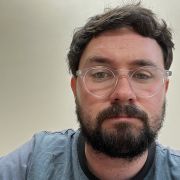Dr James Simpson
BA MLA MA PhD
School of Architecture and Landscape
Lecturer


Full contact details
School of Architecture and Landscape
Floor 12
Arts Tower
Western Bank
Sheffield
S10 2TN
- Profile
-
I am interested in understanding how people experience, interact with and adapt urban spaces and residential environments. This serves as a foundation for exploring how design actions can encourage positive connections between people and these places that they routinely inhabit and use.
I arrived in Sheffield in 2008 to study Landscape Architecture with Planning and graduated three years later with BA 1st Class (Hons), while also receiving the Wardell Armstrong and Y+H Landscape Institute Prizes. This provided the foundations for my time spent in practice, at Applied Landscape Design. I returned to Sheffield in 2012 to complete my Master of Landscape Architecture during which I time I explored the idea of pursuing research. I formulated a supervisory team comprising Dr. Kevin Thwaites (Landscape) and Dr. Megan Freeth (Psychology) with a focus towards using mobile eye-tracking to understand how people visually engage aspects of urban streets. I was successfully awarded Economic and Social Research Council funding to undertake a 1+3 Pathway Development Scholarship commencing with a MA in Landscape Research (Distinction), during which I received the IAPS Young Researchers Award. The following four years were spent undertaking my PhD (What you lookin’ at? Understanding visual engagement with urban street edges) and in 2018 I become a Lecturer in the Department of Landscape Architecture. Today, I co-lead the Socio-spatial Urbanism Unit (SsUU), an interdisciplinary group of academic researchers, teachers and practitioners exploring new agendas of thinking and theoretical development focused on social understandings of urban open spaces. This unit acts as a foundation for my research and related teaching practice – Socio-spatial Urbanism Unit.
Awards
- 2014 International Association of People Environment Studies Young Researcher Award
- 2011 Wardell Armstrong Prize for best landscape and planning portfolio
- 2011 Y+H Landscape Institute Prize for best final project
- Qualifications
-
- MA (Distinction), Landscape Research, University of Sheffield
- MLA, Master of Landscape Architecture, University of Sheffield
- BA (1st Class Hons.) Landscape Architecture with Planning, University of Sheffield
- Research interests
-
Residential environments
- Encouraging pro-environmental behaviours through design interventions
- Balancing top-down and bottom-up decision making
- Rethinking the role of private and communal spaces
Pedestrian experience
- Using real-world and virtual-reality eye-tracking to understand gaze behaviour
- Ground floor interfaces as semi-public landscapes
- Publications
-
Journal articles
- Microenvironments: towards a socio-spatial understanding of territorial expression for urban design. URBAN DESIGN International.


- Exploring the use of restorative component scale to measure street restorative expectations. URBAN DESIGN International, 27(2), 145-155.


- Street edge subdivision : structuring ground floor interfaces to stimulate pedestrian visual engagement. Environment and Planning B: Urban Analytics and City Science. View this article in WRRO


- Three-dimensional gaze projection heat-mapping of outdoor mobile eye-tracking data. Interdisciplinary Journal of Signage and Wayfinding, 5(1), 62-82. View this article in WRRO


- Transitional edges: a conceptual framework for socio-spatial understanding of urban street edges. URBAN DESIGN International, 25(4), 295-309. View this article in WRRO


- A conceptual framework for urban commoning in shared residential landscapes in the UK. Sustainability, 11(21). View this article in WRRO


- Understanding visual engagement with urban street edges along non-pedestrianised and pedestrianised streets using mobile eye-tracking. Sustainability, 11(15). View this article in WRRO


- Visual engagement with urban street edges: insights using mobile eye-tracking. Journal of Urbanism: international research on placemaking and urban sustainability, 12(3), 259-278. View this article in WRRO


- Street DNA: the who, where and what of visual engagement with the urban street. Journal of Landscape Architecture, 13(1), 50-57. View this article in WRRO


- The Impact of Street-Edge Scales on Everyday Activities in Wuhan’s Urban Village Streets. Land, 14(2), 252-252.


Chapters
- Eye-Tracking in the Real World, Advances in Civil and Industrial Engineering (pp. 368-396). IGI Global


- Handbook of Research on Perception-Driven Approaches to Urban Assessment and Design IGI Global


Conference proceedings papers
- Microenvironments: towards a socio-spatial understanding of territorial expression for urban design. URBAN DESIGN International.
- Grants
-
- April 2013 Economic and Social Research Council 1+3 Pathway Development PhD Scholarship
- Teaching activities
-
Modules that I co-ordinate / teach:
- LSC304 – Site Planning for Housing (Landscape and Architecture Duel Module)
- LSC330 – Site Planning for Sustainable Housing
- LSC61002 – Planning Strategies to Urban Design Proposals
- LSC6005 – Special Project (Rethinking Residential)
- LSC6003 / 6140 – Masters Dissertations
- Professional activities and memberships
-
- Co-lead of Socio-Spatial Urbanism Unit
- International Association of People-environment Studies (IAPS) Member
- Department Ethics Lead
- Department Well-being Coordinator
- Department Yr 3 Lead
- Department Technology Enhanced Learning (TEL) Coordinator
